belt TOYOTA CAMRY 2020 Warranties & Maintenance Guides (in English)
[x] Cancel search | Manufacturer: TOYOTA, Model Year: 2020, Model line: CAMRY, Model: TOYOTA CAMRY 2020Pages: 260, PDF Size: 8.54 MB
Page 11 of 260
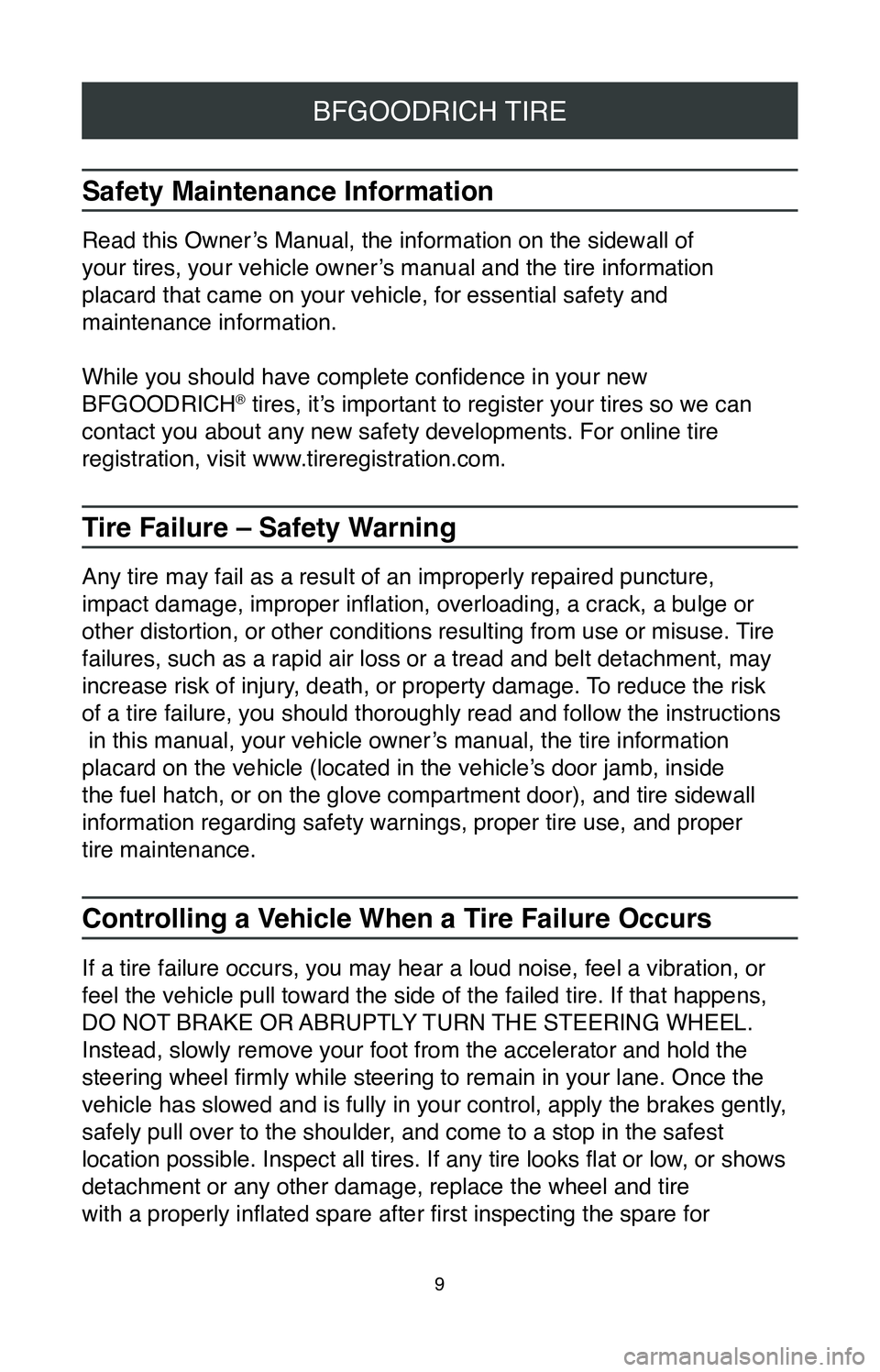
9
BFGOODRICH TIRE
Safety Maintenance Information
Read this Owner’s Manual, the information on the sidewall of
your tires, your vehicle owner’s manual and the tire information
placard that came on your vehicle, for essential safety and
maintenance information.
While you should have complete confidence in your new
BFGOODRICH
® tires, it’s important to register your tires so we can
contact you about any new safety developments. For online tire
registration, visit www.tireregistration.com.
Tire Failure – Safety Warning
Any tire may fail as a result of an improperly repaired puncture,
impact damage, improper inflation, overloading, a crack, a bulge or
other distortion, or other conditions resulting from use or misuse. Tire
failures, such as a rapid air loss or a tread and belt detachment, may
increase risk of injury, death, or property damage. To reduce the risk
of a tire failure, you should thoroughly read and follow the instruction\
s
in this manual, your vehicle owner’s manual, the tire information
placard on the vehicle (located in the vehicle’s door jamb, inside
the fuel hatch, or on the glove compartment door), and tire sidewall
information regarding safety warnings, proper tire use, and proper
tire maintenance.
Controlling a Vehicle When a Tire Failure Occurs
If a tire failure occurs, you may hear a loud noise, feel a vibration, o\
r
feel the vehicle pull toward the side of the failed tire. If that happen\
s,
DO NOT BRAKE OR ABRUPTLY TURN THE STEERING WHEEL.
Instead, slowly remove your foot from the accelerator and hold the
steering wheel firmly while steering to remain in your lane. Once the
vehicle has slowed and is fully in your control, apply the brakes gently\
,
safely pull over to the shoulder, and come to a stop in the safest
location possible. Inspect all tires. If any tire looks flat or low , or shows
detachment or any other damage, replace the wheel and tire
with a properly inflated spare after first inspecting the spare for
Page 42 of 260
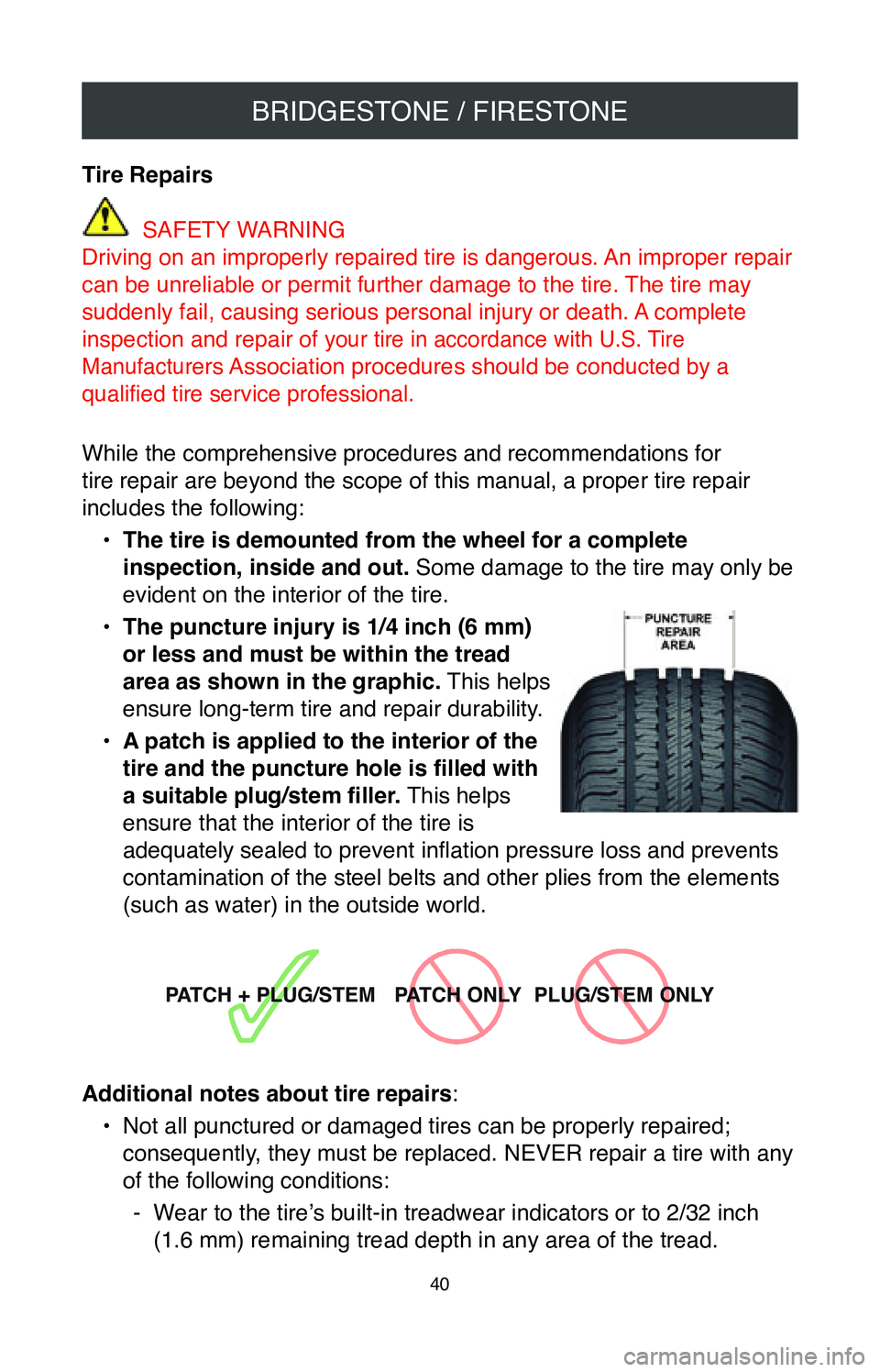
BRIDGESTONE / FIRESTONE
40
Tire Repairs
SAFETY WARNING
Driving on an improperly repaired tire is dangerous. An improper repair
can be unreliable or permit further damage to the tire. The tire may
suddenly fail, causing serious personal injury or death. A complete
inspection and repair of
your tire in accordance with U.S. Tire
Manufactur
ers Association procedures should be conducted by a
qualified tire service professional.
While the comprehensive procedures and recommendations for
tire repair are beyond the scope of this manual, a proper tire repair
includes the following:
•
The tire is demounted from the wheel for a complete
inspection, inside and out. Some damage to the tire may only be
evident on the interior of the tire.
•
The puncture injury is 1/4 inch (6 mm)
or less and must be within the tread
area as shown in the graphic. This helps
ensure long-term tire and repair durability.
•
A patch is applied to the interior of the
tire and the puncture hole is filled with
a suitable plug/stem filler. This helps
ensure that the interior of the tire is
adequately sealed to prevent inflation pressure loss and prevents
contamination of the steel belts and other plies from the elements
(such as water) in the outside world.
PATCH + PLUG/STEM PATCH ONLY PLUG/STEM ONLY
Additional notes about tire repairs :
•
Not all punctured or damaged tires can be properly repaired;
consequently, they must be replaced. NEVER repair a tire with any
of the following conditions:
- Wear to the tire’s built-in treadwear indicators or to 2/32 inch (1.6 mm) remaining tread depth in any area of the tread.
Page 43 of 260
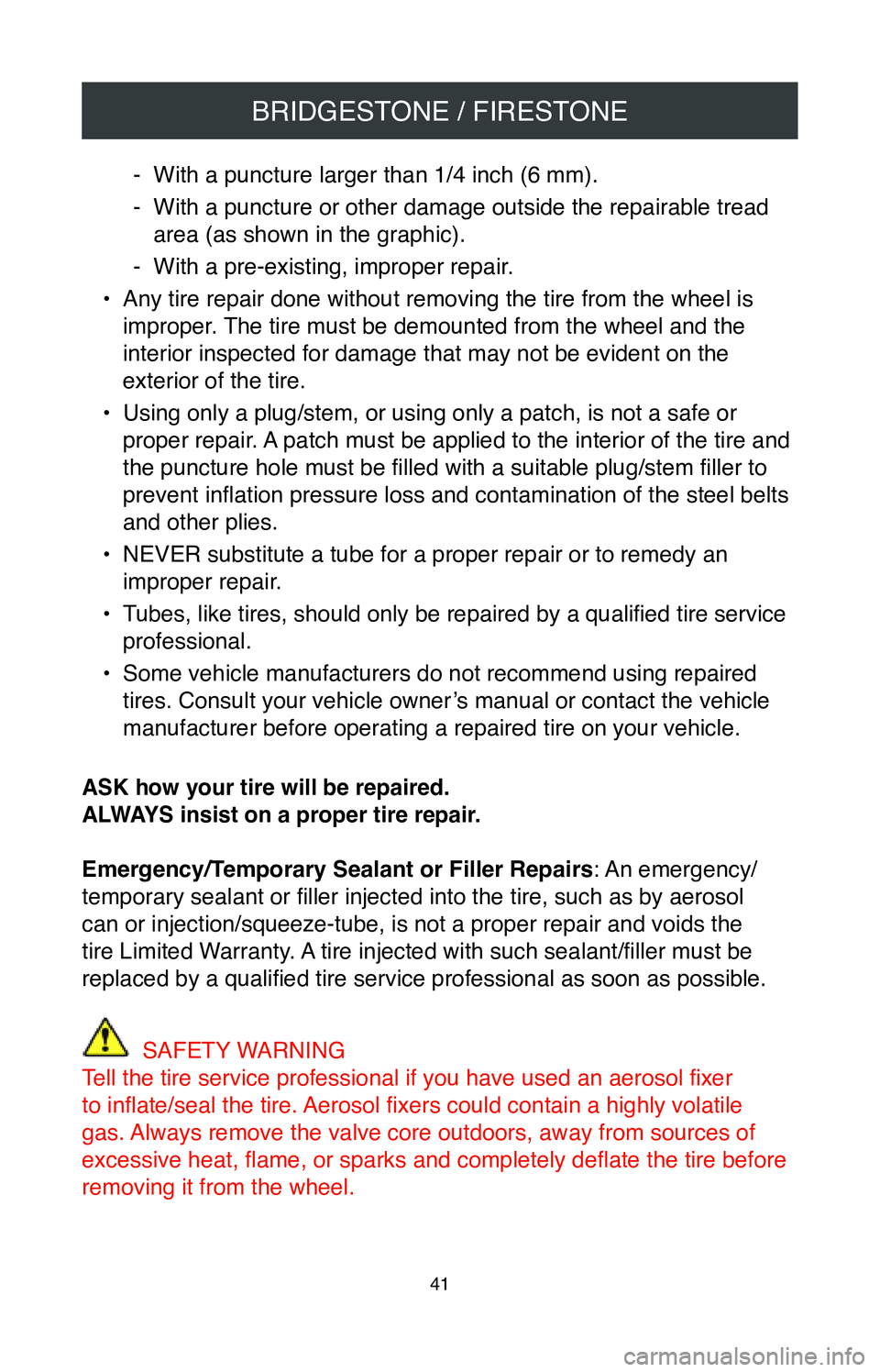
BRIDGESTONE / FIRESTONE
41
- With a puncture larger than 1/4 inch (6 mm).
-With a puncture or other damage outside the repairable tread
area (as shown in the graphic).
- With a pre-existing, improper repair.
•
Any tire repair done without removing the tire from the wheel is
improper. The tire must be demounted from the wheel and the
interior inspected for damage that may not be evident on the
exterior of the tire.
•
Using only a plug/stem, or using only a patch, is not a safe or
proper repair. A patch must be applied to the interior of the tire and
the puncture hole must be filled with a suitable plug/stem filler to
prevent inflation pressure loss and contamination of the steel belts
and other plies.
•
NEVER substitute a tube for a proper repair or to remedy an
improper repair.
•
Tubes, like tires, should only be repaired by a qualified tire service
professional.
•
Some vehicle manufacturers do not recommend using repaired
tires. Consult your vehicle owner’s manual or contact the vehicle
manufacturer before operating a repaired tire on your vehicle.
ASK how your tire will be repaired.
ALWAYS insist on a proper tire repair.
Emergency/Temporary Sealant or Filler Repairs: An emergency/
temporary sealant or filler injected into the tire, such as by aerosol
can or injection/squeeze-tube, is not a proper repair and voids the
tire Limited Warranty. A tire injected with such sealant/filler must be
replaced by a qualified tire service professional as soon as possible.
SAFETY WARNING
Tell the tire service professional if you have used an aerosol fixer
to inflate/seal the tire. Aerosol fixers could contain a highly volatile
gas. Always remove the valve core outdoors, away from sources of
excessive heat, flame, or sparks and completely deflate the tire before
removing it from the wheel.
Page 82 of 260
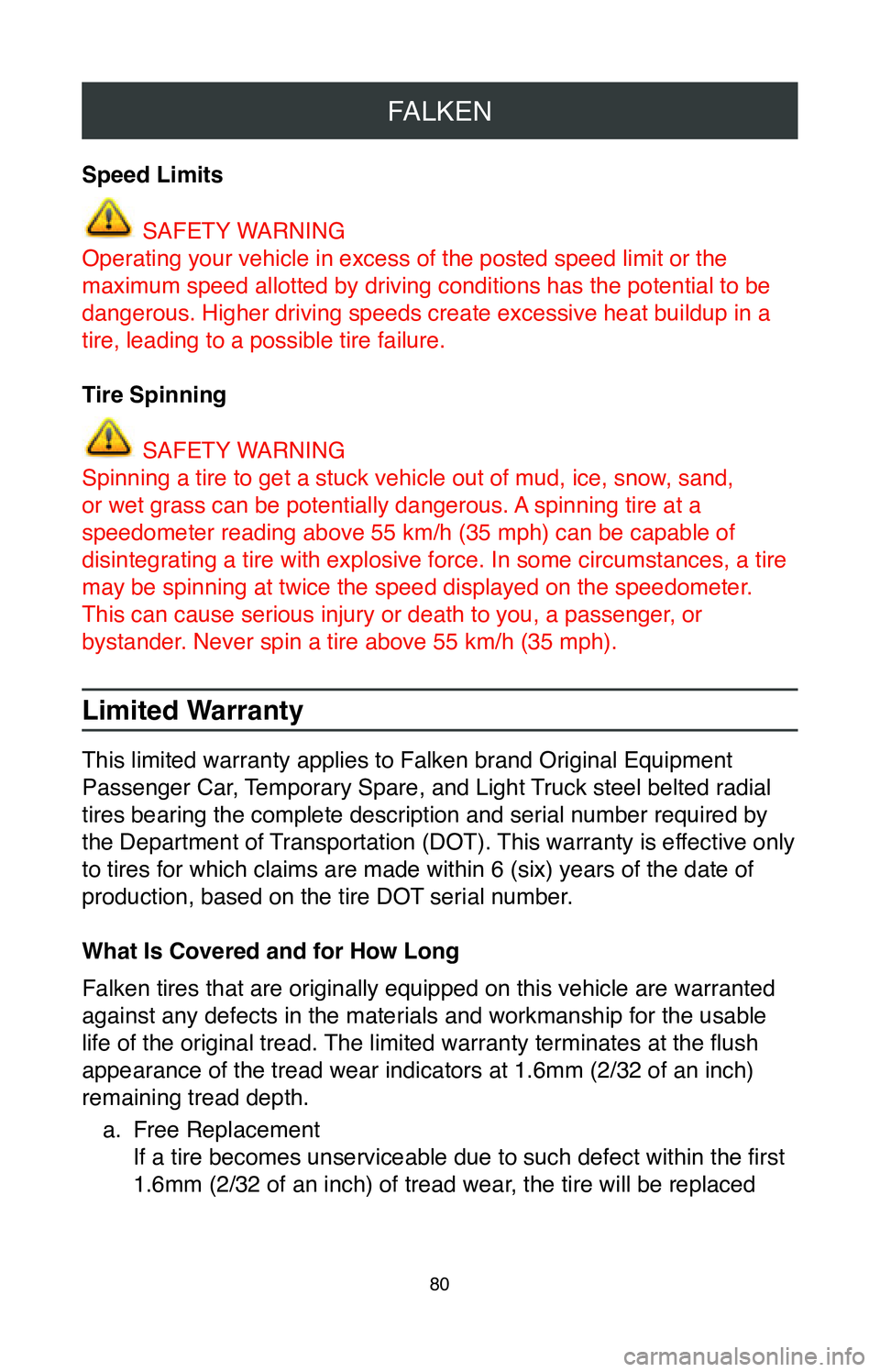
FALKEN
80
Speed Limits
SAFETY WARNING
Operating your vehicle in excess of the posted speed limit or the
maximum speed allotted by driving conditions has the potential to be
dangerous. Higher driving speeds create excessive heat buildup in a
tire, leading to a possible tire failure.
Tire Spinning
SAFETY WARNING
Spinning a tire to get a stuck vehicle out of mud, ice, snow, sand,
or wet grass can be potentially dangerous. A spinning tire at a
speedometer reading above 55 km/h (35 mph) can be capable of
disintegrating a tire with explosive force. In some circumstances, a tir\
e
may be spinning at twice the speed displayed on the speedometer.
This can cause serious injury or death to you, a passenger, or
bystander. Never spin a tire above 55 km/h (35 mph).
Limited Warranty
This limited warranty applies to Falken brand Original Equipment
Passenger Car, Temporary Spare, and Light Truck steel belted radial
tires bearing the complete description and serial number required by
the Department of Transportation (DOT). This warranty is effective only
to tires for which claims are made within 6 (six) years of the date of
production, based on the tire DOT serial number.
What Is Covered and for How Long
Falken tires that are originally equipped on this vehicle are warranted \
against any defects in the materials and workmanship for the usable
life of the original tread. The limited warranty terminates at the flush
appearance of the tread wear indicators at 1.6mm (2/32 of an inch)
remaining tread depth.
a.
Free Replacement
If a tire becomes unserviceable due to such defect within the first
1.6mm (2/32 of an inch) of tread wear, the tire will be replaced
Page 125 of 260
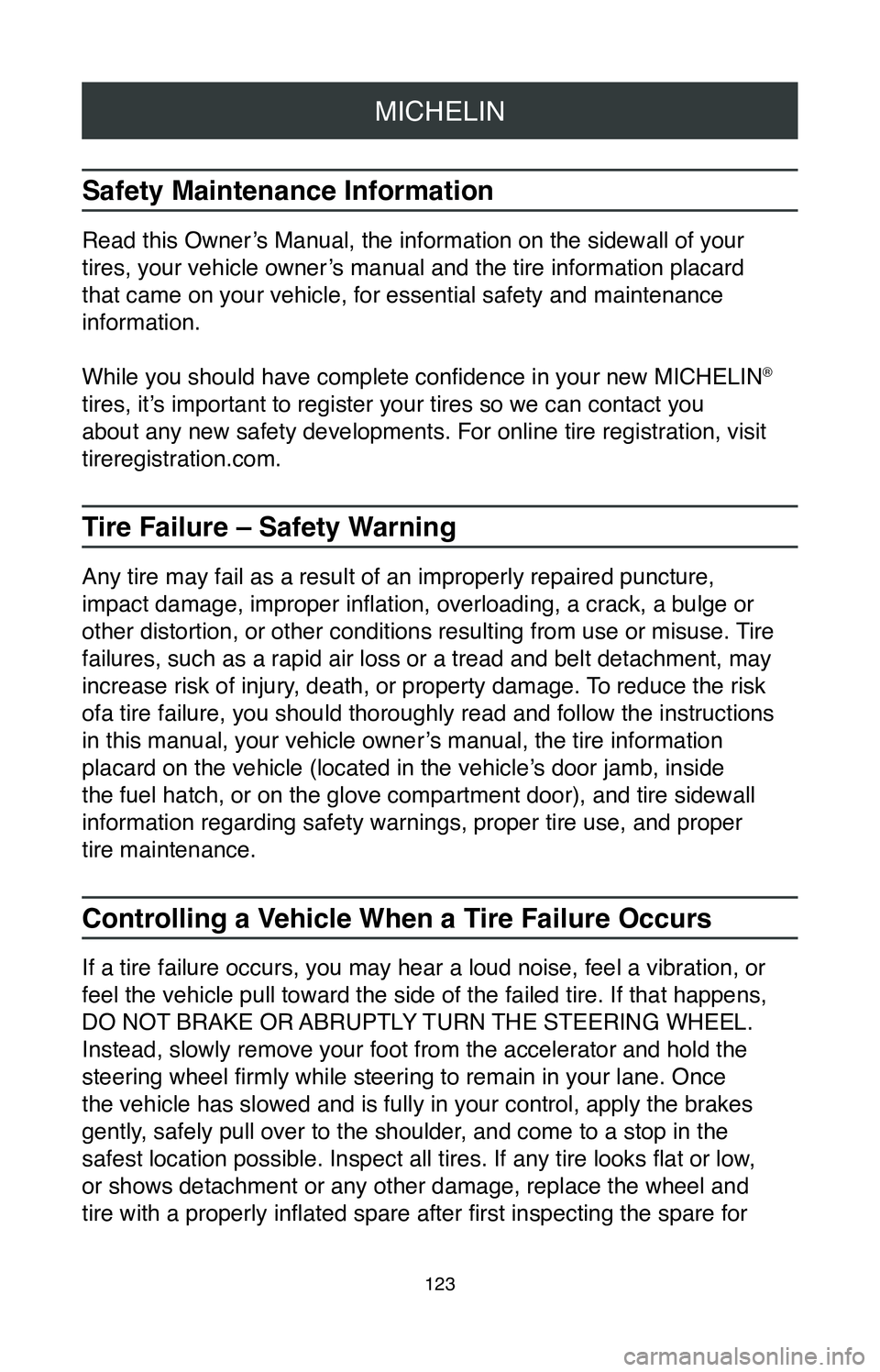
MICHELIN
123
Safety Maintenance Information
Read this Owner’s Manual, the information on the sidewall of your
tires, your vehicle owner’s manual and the tire information placard
that came on your vehicle, for essential safety and maintenance
information.
While you should have complete confidence in your new MICHELIN
®
tires, it’s important to register your tires so we can contact you
about any new safety developments. For online tire registration, visit
tireregistration.com.
Tire Failure – Safety Warning
Any tire may fail as a result of an improperly repaired puncture,
impact damage, improper inflation, overloading, a crack, a bulge or
other distortion, or other conditions resulting from use or misuse. Tire
failures, such as a rapid air loss or a tread and belt detachment, may
increase risk of injury, death, or property damage. To reduce the risk
ofa tire failure, you should thoroughly read and follow the instructions\
in this manual, your vehicle owner’s manual, the tire information
placard on the vehicle (located in the vehicle’s door jamb, inside
the fuel hatch, or on the glove compartment door), and tire sidewall
information regarding safety warnings, proper tire use, and proper
tire maintenance.
Controlling a Vehicle When a Tire Failure Occurs
If a tire failure occurs, you may hear a loud noise, feel a vibration, o\
r
feel the vehicle pull toward the side of the failed tire. If that happen\
s,
DO NOT BRAKE OR ABRUPTLY TURN THE STEERING WHEEL.
Instead, slowly remove your foot from the accelerator and hold the
steering wheel firmly while steering to remain in your lane. Once
the vehicle has slowed and is fully in your control, apply the brakes
gently, safely pull over to the shoulder, and come to a stop in the
safest location possible. Inspect all tires. If any tire looks flat or low ,
or shows detachment or any other damage, replace the wheel and
tire with a properly inflated spare after first inspecting the spare for
Page 201 of 260
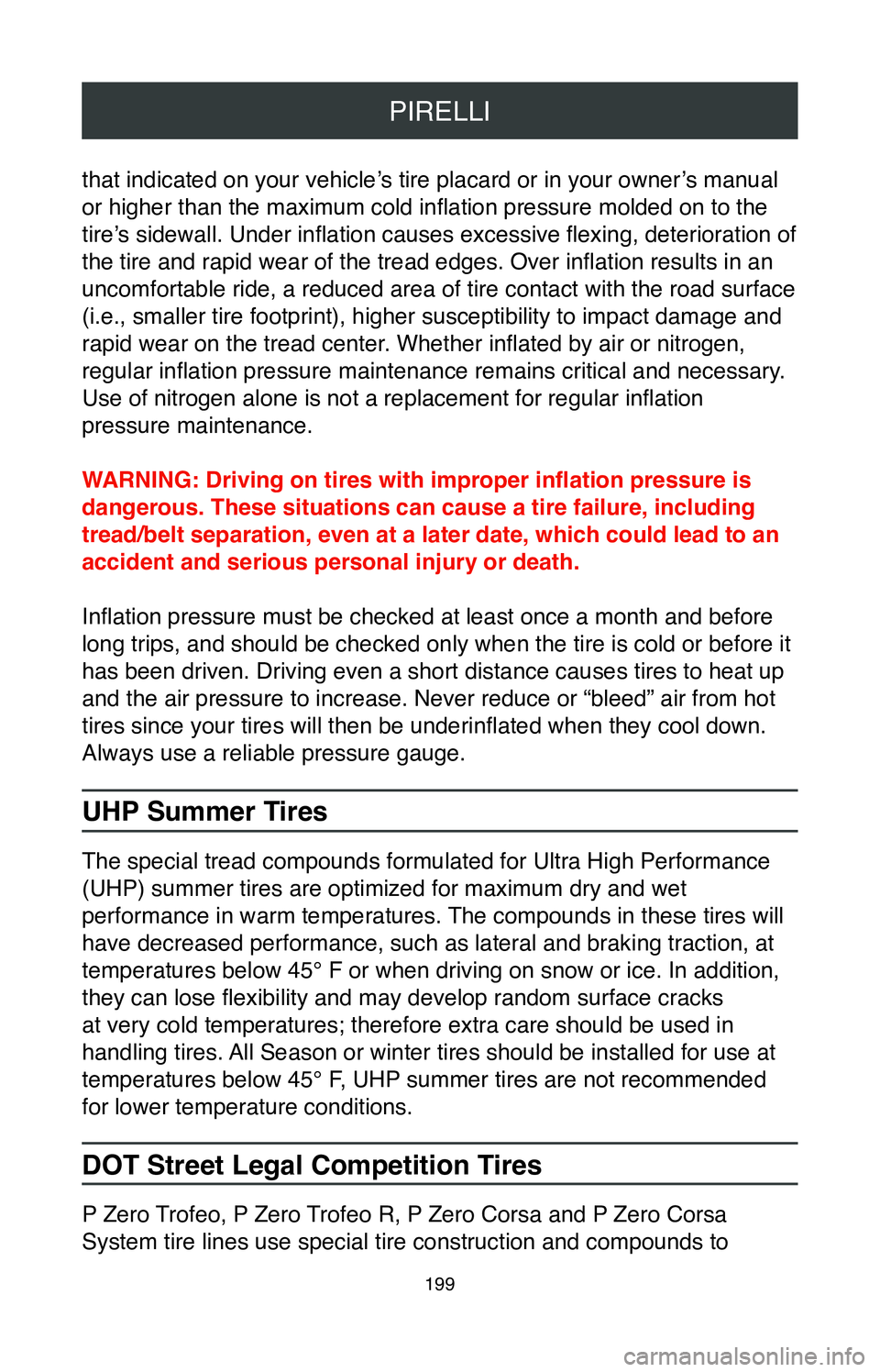
PIRELLI
199
that indicated on your vehicle’s tire placard or in your owner’s manual
or higher than the maximum cold inflation pressure molded on to the
tire’s sidewall. Under inflation causes excessive flexing, deterioration of
the tire and rapid wear of the tread edges. Over inflation results in an
uncomfortable ride, a reduced area of tire contact with the road surface\
(i.e., smaller tire footprint), higher susceptibility to impact damage and
rapid wear on the tread center. Whether inflated by air or nitrogen,
regular inflation pressure maintenance remains critical and necessary.
Use of nitrogen alone is not a replacement for regular inflation
pressure maintenance.
WARNING: Driving on tires with improper inflation pressure is
dangerous. These situations can cause a tire failure, including
tread/belt separation, even at a later date, which could lead to an
accident and serious personal injury or death.
Inflation pressure must be checked at least once a month and before
long trips, and should be checked only when the tire is cold or before i\
t
has been driven. Driving even a short distance causes tires to heat up
and the air pressure to increase. Never reduce or “bleed” air from\
hot
tires since your tires will then be underinflated when they cool down.
Always use a reliable pressure gauge.
UHP Summer Tires
The special tread compounds formulated for Ultra High Performance
(UHP) summer tires are optimized for maximum dry and wet
performance in warm temperatures. The compounds in these tires will
have decreased performance, such as lateral and braking traction, at
temperatures below 45° F or when driving on snow or ice. In addition,\
they can lose flexibility and may develop random surface cracks
at very cold temperatures; therefore extra care should be used in
handling tires. All Season or winter tires should be installed for use at
temperatures below 45° F, UHP summer tires are not recommended
for lower temperature conditions.
DOT Street Legal Competition Tires
P Zero Trofeo, P Zero Trofeo R, P Zero Corsa and P Zero Corsa
System tire lines use special tire construction and compounds to